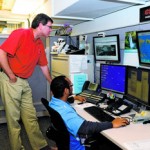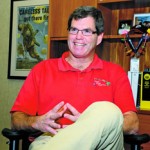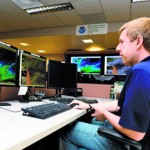One Disaster After Another
When the next tsunami or hurricane approaches Hawaii, and we know it will happen sooner or later, Doug Mayne of state Civil Defense and colleagues are armed with technology advances that allow more accurate warnings
We live with the daily threat of tsunamis, floods, hurricanes. Thanks to technology advances, Doug Mayne of Civil Defense and others in the disaster biz can provide more timely and more accurate warnings
Doug Mayne’s career is one disaster after another. But we hired him anyway. Actually, it qualifies him for an important job in the state, and when we tell you what he does, you’ll be glad he can dissect a disaster.
Mayne, a retired Army National Guard officer, is vice director of Hawaii State Civil Defense. He is the goto guy at the helm of critical data and procedures for emergency management in our state. His responsibilities cover both response and recovery phases of declared crises to protect lives and property.
- State of Hawaii Civil Defense Division vice director Doug Mayne is tracking a spring storm with warning officer Cedric Mengelil
- Mayne is grateful for advances in technology that allow for earlier warnings
- Meteorologist John Bravender discusses current weather patterns with co-workers at the NOAA office at UH-Manoa
Mayne was named to the position in March 2012, succeeding Ed Teixeira, who held the post for 12 years. It is Mayne’s duty to know disasters in detail.
No one likes to think about disasters, whether natural or man-made, but they do happen in our ever-perilous world. During April, Tsunami Awareness Month, we get face-to-face with Mayne to review his first year on the job and to look ahead.
Just being in his unique office says everything about Mayne’s world. The Hawaii State Civil Defense headquarters is in Birkhimer Bunker, a military battery built in 1916 at Diamond Head Crater. The windowless enclosure, with 6-foot-thick walls, heavily insulated ceilings and deep dens, is an impenetrable fortress.
But if you have a guest pass, you get a cordial welcome, as we did, and can view historic photos and artifacts on display before entering Mayne’s office. En route, we walk past a communications nerve center known as the State Warning Point with a line of computers and video monitors projecting satellite and radar broadcasts; two conference rooms with teleconferencing capacity; and various office and storage areas.
It’s a tight squeeze in the 5,000-square-foot space when civil defense personnel, government officials, volunteers and media are operating there during an emergency.
But on the day of our visit, it is safe haven for an enlightening exchange about Hawaii’s scope of emergency and disaster management.
Most of us don’t think about Hawaii’s civil defense except when those blaring sirens are tested once a month. Yet we have vivid memories and personal accounts of devastating events, such as the 1946 Hilo tsunami and Hurricane Iniki in 1992, that mark the Islands’ vulnerability.
“Preparing for disasters is a never-ending process,” Mayne says. “We will never be fully prepared. It takes diligent planning and training to address new threats, new technology and turnover.
“Our goal is to have a fully functional, fully integrated emergency-management system so we respond most effectively to disasters,” the 50-year-old administrator says, even while realizing Hawaii’s challenges as an island state.
Fundamentally, disasters are local events, he states. This makes emergency management a community-centric operation, supported by county agencies and grass-roots organizations. It’s not a one-size-fits-all scenario.
“Up until a couple of years ago, disaster response was seen as a government-centric operation,” Mayne cites. “My most important role is to support the county managers to make sure they have whatever they need to protect citizens and communities.”
Just as the Federal Emergency Management Agency (FEMA) has adopted a “whole community” approach of shared responsibility, so has Hawaii moved to defined partnerships with families, businesses, nonprofit and faith-based organizations, as well as community volunteers.
“Disaster preparedness and response involves everybody,” proclaims Mayne, who worked for four years as a FEMA coordinating officer based in Olympia, Wash., where he led responses to seven disasters in six states.
As Hawaii’s vice director of civil defense, he reports to Maj. Gen. Darryll Wong, state Adjutant General and director of state civil defense.
Mayne previously worked with the Hawaii Joint Force HQ staff in 2007 during the annual Makani Pahili disaster-response exercise.
Since moving to Waikiki with wife Cathe and two Boston terriers, Mayne has been entrenched in the day-to-day administration, training and readiness of state civil defense personnel.
After only a few months on the job, Mayne was put through the paces of Hawaii’s Oct. 27 tsunami threat generated from a 7.7 magnitude quake off the west coast of Canada. A statewide alert was issued after buoy readings indicated that Hawaii could be impacted. Although sea level changes and strong currents posed hazards to harbors and marinas, the tsunami warning was fortunately lifted the next day.
“Each incident is a new learning experience,” Mayne recalls. “Typically, we would have had six hours of notice. We ended up with three-and-a-half hours of notice. It’s one of those things where Mother Nature has a lot more out there that we need to know about.”
Yet Mayne acknowledges that emergency managers operate today with vastly improved warning systems.
“Scientific and technological advances have really increased warning times,” he says. “This allows us to not spin-up people before they are actually needed.
“I’ve spent my life in government service,” adds the Modesto, Calif., native. “I served 23 years in the National Guard and four years at FEMA responding to disasters and supporting authorities.
“Ninety percent of what we do requires the same action, whether it’s a natural or man-made (nuclear or bomb threat, terrorism, technological hazards) disaster,”
Mayne says. “We prepare for, respond to, recover from and mitigate disasters.
“Personal preparedness is key,” he emphasizes.
This applies also to businesses, which he suggests should have a business continuity plan.
“Forty percent of small businesses don’t reopen after disasters,” he says of the economic impact.
Even while dealing with those constants of crisis management, the force of change in our society, including the way people communicate and get information, is a perpetual storm.
“The role of social media in emergency management likely will increase in the future, and its impact will create a more complex and sometimes challenging operating environment,” in Mayne’s view.
Add to that demographic changes, such as an aging population and infrastructure, and you get a sense of what complicates future planning.
“I thank my lucky stars that I’m in Hawaii and get the kind of support we get from the Legislature,” Mayne says. “It is substantial.”
But is it always fair weather?
While metaphorically it might be, islanders know that, in reality, it is not.
To examine Civil Defense’s critical link to severe weather forecasting and monitoring, we head to the University of Hawaii Manoa campus and the National Weather Service Forecast Office (NWS) there.
The Oahu office, a division of the National Oceanic and Atmospheric Administration (NOAA), functions as the Honolulu Weather Forecast Office and Central Pacific Hurricane Center. Reports and alerts for weather-related hazards originate from a hurricane-proofed office on the second floor of the Hawaii Institute for Geophysics Building at UHManoa. The federally funded operation provides weather, water and climate data, forecasts and warnings. Each year, NWS collects some 76 billion observations and issues approximately 1.5 million forecasts and 50,000 warnings. Hawaii NWS does more than 20,000 forecasts a year.
Where one might naively expect to see weather vanes, barometers and meteorological geeks hanging their heads out the window, the NWS center looks no different than a corporate office of desks with computer monitors, remote terminals and phones. The 24/7 operation is manned by 35 meteorologists and 29 staffers.
While this might seem like overkill for a tropical haven like Hawaii, where the forecast is almost predictable from day to day, NWS has jurisdiction for the vast Pacific region that includes Guam, Northern Mariana Islands, Micronesia, Marshall Islands, Palau and American Samoa.
Meteorologists use a combination of computer models, observation and knowledge of trends and patterns to do forecasts, aided by satellite and radar data. These models are used by agencies, private industry and news services in preparing daily forecasts that affect domestic, commercial and economic activity. NOAA refers to its mission as establishing a “weather-ready” nation.
Hawaii’s history of destructive hurricanes and tsunamis has made residents very receptive to preparedness information, according to Michael Cantin, NWS warning coordination meteorologist. He cites the close partnership with Hawaii State Civil Defense and other agencies to support the dissemination of information.
“Technology is designed to better pinpoint potential hazards earlier to give better lead time to react and make decisions,” he says. “Access to this information through the products we develop for public and other uses is essential in this age of instant communication.”
Gone is the folklore of farmers predicting rain when they saw cattle lying in fields or sailors anticipating storms with red skies. (Although Grandma’s knee pains were never wrong.)
In all of this, Mayne and Cantin underscore the importance of individual preparedness and kuleana (responsibility) for protecting lives and property in severe weather and catastrophic episodes.
Have a disaster kit. Have a disaster plan. Stay informed (www.scd.hawaii.gov) (www.prh.noaa.gov/hnl/).
In other words: Be prepared to help yourself, because they can’t help everyone.






